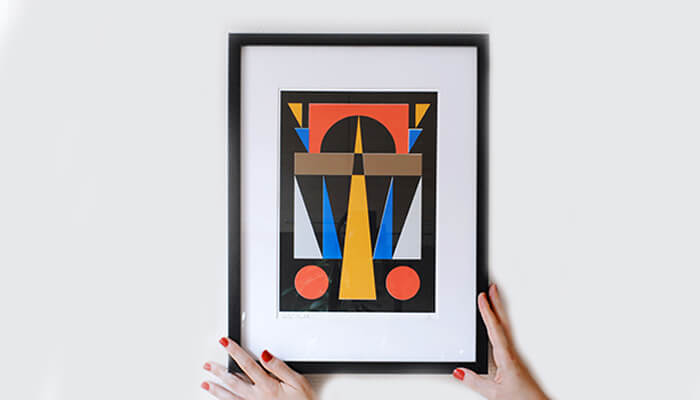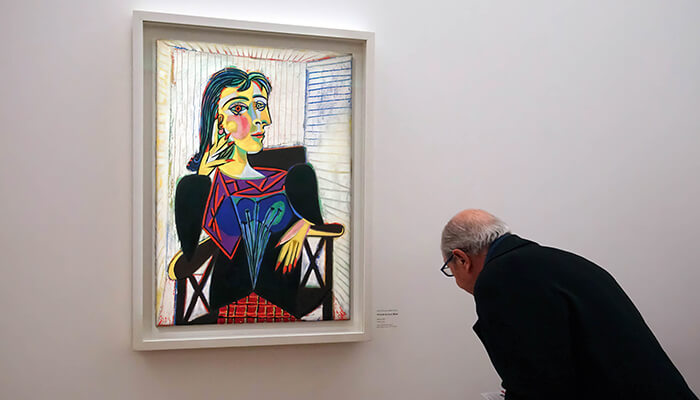Choosing the perfect frame for your artwork can be an excruciating process. There are many factors to consider, such as colour, size, and style. Follow our tips below to choose the perfect frame for your artwork.
Mounting for 2D artwork
If your artwork is on paper, or another 2D medium, start by considering whether you are going to mount your artwork. A mount is a stiff piece of card which acts as a spacer between your artwork and the frame. It sits on top of the artwork, creating a small gap between the artwork surface and the front of the frame. In addition, it can be used to ‘tidy’ the edges of a piece of artwork if needed.
A mount is often used for photographs, illustrations, or contemporary artwork. It provides space around your artwork to avoid it feeling cramped. Some minimalistic and contemporary artists choose oversized mounts to create a dramatic effect.
It’s also worth bearing in mind that the mount increases the overall size of the artwork. If the artwork is quite small, a mount can be helpful to make the minute details stand out on a large wall.
Opting for no Mount
Mounting your artwork isn’t a necessity. If your artwork is already surrounded by a lot of white space, you may just opt for a frame.
Canvas paintings also don’t require a mount, as often the frame is just used to cover the edges of the canvas.
If you are not using a mount, you will need to make sure that the type of frame chosen will cover the gap between the frame and the artwork. All too often, an ugly gap around the edge of the artwork becomes visible without a mount, so be careful to choose a frame which has a lip around the inside edge.
Floating frames
Particularly effective for contemporary artwork or photographs, a floating frame provides a sleek, modern finish to your artwork. A floating frame comprises of the artwork sandwiched between two larger pieces of glass, bordered by a standard frame. A large gap is left between the edge of the artwork and the frame to allow the colour of the wall to be visible through the glass.
We’ve found that floating frames are super effective for digital artwork and photography, as it matches the clean lines.
Colour: Frame and Mount
Once you’ve decided whether you require a mount, it’s time to consider one of the most important choices: colour.
We recommend considering the colour of the frame and the mount together, as these two colours must work together in harmony to showcase your artwork. The colour of the mount is often light-coloured, to create a distinct border around the artwork. The most common colours available are white, cream, and grey.
A white mount can provide a stark contrast to the artwork and make any bright colours pop. It works well with most coloured frames and wall colour. However, if your artwork is comprised of subtle colours and light tones, you may decide that white is too harsh for your artwork. A suitable alternative would be an off-white or cream, which provides a softer tone to complement your artwork.
The colour of the frame is often dark coloured to draw attention to your artwork and make it stand out on the wall. A black frame is the most dramatic and works well for monotone artwork or photographs. However, you may decide that a black frame is too heavy for your artwork, particularly if your artwork is light or subtle coloured. In which case, choose the most dominant mid-tone colour in your artwork and match that colour to the frame. Matching the frame colour to the artwork can really help the colours pop.
Thickness and Style
Once you’ve decided on the colour combinations of your artwork, consider the style of your artwork. Is it fresh and modern? Is it rich and textured? Is it minimalist, or highly complex?
Matching the frame to your artwork style is extremely important to create a coherent look. A classical oil painting would look out of place in an ultra-modern frame, for example.
Modern pieces of art often look best in clean-cut, straight edged frames. The sharp edges complement the modern style. For a dramatic look, choose an ultra-thick frame to steal everybody’s attention. However, make sure that the artwork is not overpowered by the frame- it still needs to be the star of the show!
Alternatively, a more natural or free-flowing style of artwork is often best paired with bevelled or rounded frames. A delicate piece of artwork could also be paired with an intricately designed frame to create a stunning effect.
Choosing the front: Glass, Plastic, or Nothing?
Most frames provide a glass or acrylic layer to protect the artwork from damage. It is also helpful for preventing dust collecting on the surface.
Glass is generally preferable to acrylic, due to its superior light transmission properties. Compared to acrylic, high-quality glass is clear and colourless, preventing any unwanted colour cast. Low quality glass or acrylic can absorb some light, tinting the artwork green or brown.
The alternative is to opt for no protective layer at all; in fact, some artists who work with textures and 3D relief work choose to deliberately leave the artwork exposed for the full effect. Just be aware that this will not preserve the artwork and protect it from damage- so be careful!
Choosing the final frame
With so many options, we recommend creating a digital mock up of a few of your favourite options. Try 3 different frame colours as well as a couple of different mount colours. Preview the options from a distance and see which one catches your eye. Look for a frame which enhances but doesn’t overpower your artwork. Afterall, you want to showcase the artwork, not the frame!
Lastly, if you know where the artwork will be hung, you might want to consider the wall colour. Mostly, this is only an issue when either the wall colour or the frame colour is particularly bright. If in doubt, opt for neutrals or black, grey or white to match any colour scheme!




